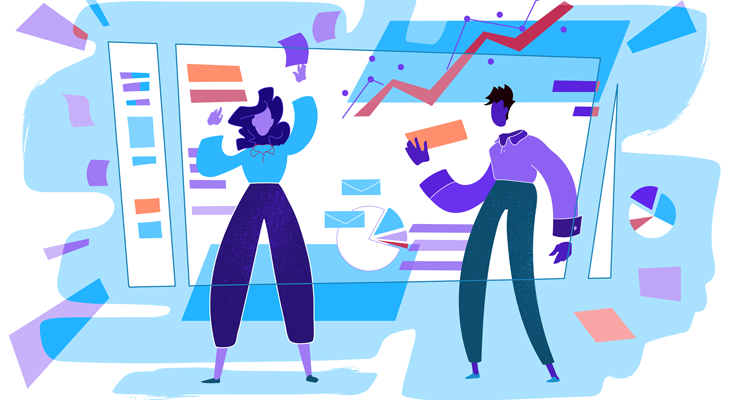
How often do you find yourself at work flipping between tabs, unable to complete a thought before moving onto something else? You go from answering an email to checking a Facebook notification to reading some LinkedIn article, and then – what was I doing? Oh yeah, answering that email.
It’s the digital equivalent of walking into a room and forgetting why you needed to go in there – and we do it all the time.
Throughout the work day, our brains flutter from meetings to emails to calls with little room to breathe. During our lunch “breaks,” we’re working, thinking about work, or scrolling through something on our phones. We’re multitasking while we work, eat, and even use the restroom.
At the end of the day, we’re exhausted – with little energy left to spare for hobbies or exercise or spending quality time with our loved ones.
Trying to multitask, constantly, during all waking hours, is making us anxious, depressed, and socially isolated — but it doesn’t have to be this way. At the heart of all of these issues is our inability to focus, which stems from a lack of intentionality. If we can be more intentional with our time and energy, we can regain the focus we need to feel fulfilled by work again – and keep it from bleeding into the other parts of our lives.
But how do we find intentionality in our work when there is so much to do, all the time? It’s not easy – but it is possible. Kanban (pronounced kahn-bahn) is a way of thinking about and managing work that can bring discipline and focus into your workday. Kanban provides that clarity through this one concept: Visualize your workflow. Visualizing your workflow sounds like an overly simplistic solution, but it can truly work wonders on your ability to think and work with clarity and purpose. By encouraging you to identify, prioritize, and intentionally complete work items one at a time, Kanban can help combat the damaging effects of multitasking in a hyper-stimulated world.
VISUALIZATION AND WHY IT MATTERS
There are two elements to this concept: First, visualization. We are bombarded by textual information – emails, texts, articles, notifications, etc. every day. It can feel impossible to keep all of this information straight – especially when you’re trying to decide what to work on or how to prioritize your time. This is because our brains aren’t designed to process so much text information at once – in fact, research shows that the more information we try to process, the less effectively we’re able to filter through information. The more distracted we are by information, the less able to make informed decisions about what is or is not important – sounds like an ideal mindset for working, right?
Luckily, our brains are designed to efficiently absorb visual information – so the more we visualize what’s most important to us, the more likely we will be able to stay on task and get things done.
GAINING CONTROL OVER YOUR WORKFLOW (AND WHY YOU SHOULD CARE)
The second element is workflow – Kanban is all about gaining control over your process, and this starts by visualizing it accurately. Your workflow is the mechanism by which work goes from To Do to Done. Without Kanban, most of our workflows look something like this:

Your goal should be to turn that squiggle into a straight line… You do this by figuring out upfront what steps need to be taken on a piece of work, and then doing them in that order. Sounds simple, right? But most of our processes are far from linear. Think about the last project you completed, and the process it went through to go from To Do to Done – was it linear? Did it move smoothly through your process, or did it stop and start and backtrack? Did you finish it on time, or did it take you longer than expected?
KANBAN BASICS: BOARDS AND CARDS
Now that you know the what of Kanban, let’s discuss the how. Kanban uses boards – Kanban boards – to represent your process, and cards to represent your work items. Every Kanban board reflects some version of this basic workflow: To Do, Doing, and Done.
To Do > Doing > Done
The first step to practicing Kanban is to customize your board to accurately reflect your unique process. Here are some examples of different Kanban boards for a marketing team, software development team, and an individual managing personal projects.
Marketing: Backlog > Planning/Research > Testing > Implementation > Analysis > Done
Software Development: Backlog > Gather Requirements > Doing > QA > Deploy > Done
Individual: To Do > Planning > Doing > Reviewing > Done
What is that process for you? We can’t tell you that – but we do have an exercise that can help you figure it out – download our Kanban Roadmap to learn how to identify the steps in your process and design a Kanban board that reflects it.
Kanban harnesses our brain’s innate preference for consuming visual information. It helps us clear through mental clutter and stay focused on delivering on our bigger goals – something we are unable or unwilling to do when left to our own devices, because it goes against a lot of what we’ve been taught about productivity.
We all know people who brag about their ability to multitask: They say it’s possible to watch and retain information from a webinar while getting caught up on email while ordering a few household needs on Amazon. By now, you should recognize the inefficiency in this sort of behavior – you know that the person has probably retained only the basics from the webinar, that they probably made a few errors in their responses to emails, and that they most likely forgot a few essential items from their Amazon list. Why? Because they weren’t using their full brain for any of these activities.
Multitasking is a silent killer of productivity, disguised as a ‘life hack.’ In the book Organize Your Mind, Organize Your Life, authors Dr. Paul Hammerness and Margaret Moore describe how multitasking increases the risk for making mistakes and missing important information and cues. Their research shows that people who multitask are less likely to retain information in working memory, which can hinder problem solving and creativity. Yikes!
The antidote to multitasking, is of course single-tasking, or as the authors call it, set shifting. Set shifting involves focusing on completing one task at a time, and then actively and intentionally shifting our focus over to the next task only when the first task is done. Practicing set shifting helps you give your full brain’s attention to the task at hand – helping you do it better.
Of course, breaking the pattern of multitasking at work can’t happen overnight. We have to actively train our brains to stop craving the stimulation of multitasking, and instead encourage our brains to enjoy the freedom and clarity of completing one thing at a time. Kanban can help facilitate this transition. Over time, using Kanban to manage your work will help you master the practice of single-tasking – staying focused on completing one task at a time. This will not only make you more productive – it will make your brain happier and healthier, too.
LEARN MORE
To get started with Kanban, download our Kanban Roadmap and follow the exercises within it to create your first Kanban board. You can learn more about Kanban by visiting the Lean and Agile category on the Planview blog.




